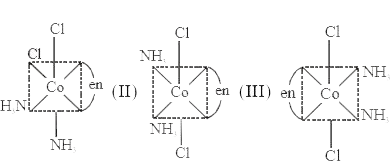[Co(en)3]3+ ion is expected to show :-
Two optically active isomers
Two optically inactive isomers
four optically active isomers, cis, d & l from and trans d & l form
None
The correct Answer is:A
To determine the expected behavior of the (Co(en)₃)3+ ion, we need to analyze its structure and properties step by step.
Step 1: Identify the Coordination Complex
The complex in question is (Co(en)₃)3+, where "en" stands for ethylenediamine, a bidentate ligand. This means that each ethylenediamine molecule can bind to the cobalt ion at two sites.
Hint: Remember that bidentate ligands can create chelate rings with the metal ion.
Step 2: Determine the Coordination Number
Cobalt in this complex has a coordination number of 6 because it is surrounded by three ethylenediamine ligands, each contributing two coordination sites.
Hint: The coordination number is determined by the number of donor atoms from ligands surrounding the metal ion.
Step 3: Analyze the Geometry
With a coordination number of 6, the geometry of the complex is octahedral. In an octahedral arrangement, the ligands can be arranged in various ways, leading to different isomers.
Hint: Visualize the octahedral structure to understand how the ligands can be positioned relative to each other.
Step 4: Consider Optical Isomerism
In octahedral complexes with bidentate ligands, the arrangement of the ligands can lead to the formation of optical isomers. Optical isomers are non-superimposable mirror images of each other. For (Co(en)₃)3+, there are two distinct arrangements that can exist, leading to two optically active isomers.
Hint: Think about how the arrangement of ligands can create chiral centers, resulting in non-superimposable mirror images.
Step 5: Conclusion
Thus, the (Co(en)₃)3+ ion is expected to show two optically active isomers due to its chiral nature in the octahedral geometry.
Final Answer: The correct answer is that (Co(en)₃)3+ shows two optically active isomers.
The complex in question is (Co(en)₃)3+, where "en" stands for ethylenediamine, a bidentate ligand. This means that each ethylenediamine molecule can bind to the cobalt ion at two sites.
Cobalt in this complex has a coordination number of 6 because it is surrounded by three ethylenediamine ligands, each contributing two coordination sites.
With a coordination number of 6, the geometry of the complex is octahedral. In an octahedral arrangement, the ligands can be arranged in various ways, leading to different isomers.
In octahedral complexes with bidentate ligands, the arrangement of the ligands can lead to the formation of optical isomers. Optical isomers are non-superimposable mirror images of each other. For (Co(en)₃)3+, there are two distinct arrangements that can exist, leading to two optically active isomers.
Thus, the (Co(en)₃)3+ ion is expected to show two optically active isomers due to its chiral nature in the octahedral geometry.
Topper's Solved these Questions
- INORGANIC CHEMISTRYBOOK - ALLENCHAPTER - INORGANIC CHEMISTRYEXERCISE - COORDINATION COMPOUNDS & d-BLOCK COMPOUNDS (MATCH THE COLUMN)
2 Videos
- INORGANIC CHEMISTRYBOOK - ALLENCHAPTER - INORGANIC CHEMISTRYEXERCISE - p-BLOCK ELEMENT
80 Videos
- INORGANIC CHEMISTRYBOOK - ALLENCHAPTER - INORGANIC CHEMISTRYEXERCISE - CHEMICAL BONDING
119 Videos
- HYDROGENBOOK - ALLENCHAPTER - HYDROGENEXERCISE - EXERCISE-5
17 Videos
- Ionic EquilibriumBOOK - ALLENCHAPTER - Ionic EquilibriumEXERCISE - All Questions
37 Videos
Similar Questions
Out of CO2 and NH3 gases, which is expected to show more deviation from the ideal gas behavior ?
View SolutionThe compound (SiH3)3N is expected to be
View SolutionWhich of these ions is expected to be colored in aqeous solution?
[I] Fe3+ [II] Zn2+ [III] AI3+ [IV] Sc3+
View SolutionFor the coordination complex ion [Co(NH3)6]3+.
What is the oxidation number of cobalt in the complex ion?
View SolutionThree arrangements are shown for the complex [Co(en)(NH3)2Cl2]+ pick up the correct statement:-

View SolutionExplain the structure of CO2−3 ion in terms of resonance
View SolutionAssertion: Complex ion [Co(NH3)6]2+ is readily oxidized to [Co(NH3)6]3+
Reason: Unpaired electron in complex ion [Co(NH3)6]2+ is present in 4p orbital.
View SolutionThe complex ion [Co(NH3)6]3+ is formed by sp3d2 hybridiration. Hence, the ion should posses
View SolutionDraw the Lewis symbol for Calcium.
Will it form an ion? What is the expected charge on ion?
View Solution(a) What is meant by the term lanthanoid contraction ? What is it due to and what consequences does it have on the chemistry of elements following lanthanoids in the periodic table ?
(b) Explain the following observations :
(i) Cu+ ion is unstable in aqueous solutions .
(ii) Although Co2+ ion appears to be stable , it is easily oxidised to Co3+ ion in the presence of a strong ligand.
(iii) The E∘Mn2+/Mn value for manganese is much more than expected from the trend for other elements in the series.
View Solution
